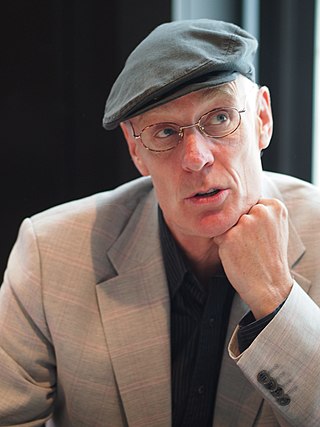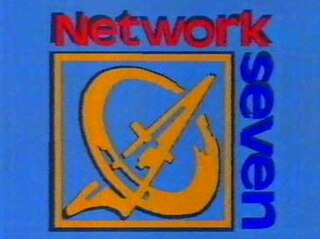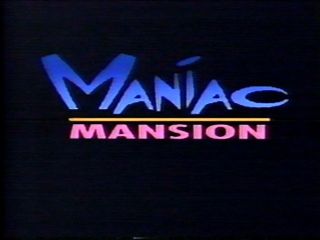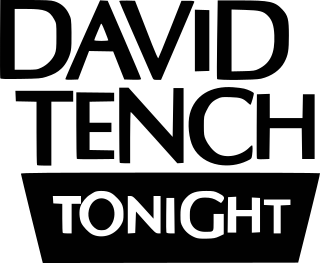
Max Headroom is an American satirical science fiction television series by Chrysalis Visual Programming and Lakeside Productions for Lorimar-Telepictures that aired in the United States on ABC from March 31, 1987, to May 5, 1988. The series is set in a futuristic dystopia ruled by an oligarchy of television networks, and features the character and media personality Max Headroom. The story is based on the Channel 4 British TV film produced by Chrysalis, Max Headroom: 20 Minutes into the Future.

Amanda Pays is an English interior designer, actress, and television presenter.

Matthew George Frewer is a Canadian-American actor and comedian. He portrayed the 1980s icon Max Headroom in the 1985 TV film and 1987 television series of the same names.
WTTW is a PBS member television station in Chicago, Illinois, United States. Owned by not-for-profit broadcaster Window to the World Communications, Inc., it is sister to commercial classical music radio station WFMT. The two stations share studios in the Renée Crown Public Media Center, located at 5400 North Saint Louis Avenue in the city's North Park neighborhood; its transmitter facility is atop the Willis Tower on South Wacker Drive in the Chicago Loop. WTTW also owns and operates The Chicago Production Center, a video production and editing facility that is operated alongside the two stations.
TechTV was a 24-hour cable and satellite channel based in San Francisco featuring news and shows about computers, technology, and the Internet. In 2004, it merged with the G4 gaming channel which ultimately dissolved TechTV programming. At the height of its six-year run, TechTV was broadcast in 70 countries, reached 43 million households, and claimed 1.9 million unique visitors monthly to its website. A focus on personality-driven product reviews and technical support made it a cultural hub for technology information worldwide, still existing today online through its former hosts' webcasts, most notably the TWiT Network.
U.S. television science fiction is a popular genre of television in the United States that has produced many of the best-known and most popular science fiction shows in the world. Most famous of all, and one of the most influential science-fiction series in history, is the iconic Star Trek and its various spin-off shows, which comprise the Star Trek franchise. Other hugely influential programs have included the 1960s anthology series The Twilight Zone, the internationally successful The X-Files, and a wide variety of television movies and continuing series for more than half a century.
A blipvert is a very brief television advertisement, lasting one second. The word is a portmanteau of blip, a brief sound, and advertisement.

Network 7 is a short-lived but influential youth music and current affairs programme screened on Channel 4 over two series in 1987 and 1988. The series was created by Jane Hewland and Janet Street-Porter, who was also editor of the first series.

Maniac Mansion is a sitcom created by Eugene Levy, which aired concurrently on YTV in Canada and The Family Channel in the United States for three seasons from September 14, 1990, to April 4, 1993.
Max Headroom is a fictional computer-generated character played by comedian Matt Frewer.
"Blipverts" is the first regular episode of the science-fiction television series Max Headroom.

Max Headroom is a fictional character played by actor Matt Frewer. Advertised as "the first computer-generated TV presenter", Max was known for his biting commentary on a variety of topical issues, arrogant wit, stuttering, and pitch-shifting voice. The character was created by George Stone, Annabel Jankel, and Rocky Morton. Max was advertised as "computer-generated", and some believed this, but he was actually actor Frewer wearing prosthetic makeup, contact lenses, and a plastic moulded suit, and sitting in front of a blue screen. Harsh lighting and other editing and recording effects heighten the illusion of a CGI character. According to his creators, Max's personality was meant to be a satirical exaggeration of the worst tendencies of television hosts in the 1980s who wanted to appeal to youth culture, yet were not a part of it. Frewer proposed that Max reflected an innocence, largely influenced not by mentors and life experience but by information absorbed from television.

David Tench Tonight was a short-lived television talk show created for Network Ten in Australia. The series featured David Tench, an animated fictional character, as host. The name "Tench" is a partial anagram created from the name Channel Ten. The actor behind the digital Tench was Australian actor Drew Forsythe.

On the night of November 22, 1987, the television signals of two stations in Chicago, Illinois, were hijacked, briefly sending a pirate broadcast of an unidentified person wearing a Max Headroom mask and costume to thousands of home viewers.
Annabel Jankel, also known as AJ Jankel, is a British film and TV director who first came to prominence as a music video director and the co-creator of the pioneering cyber-character Max Headroom and as co-director of the film adaptation of Super Mario Bros. She is the sister of musician and songwriter Chaz Jankel, who is best known as a member of new wave band Ian Dury & The Blockheads.
Rocky Morton is an English director. He is the co-creator of the TV series Max Headroom and co-director of the 1993 Hollywood Pictures film Super Mario Bros. Various music videos by Tom Tom Club, Talking Heads, Gravity Kills, Orgy, George Harrison and Miles Davis are credited to Morton. He and his then-partner, Annabel Jankel, made their television debut with the original Max Headroom: 20 Minutes into the Future, and its Americanized version. The duo made their big-screen debut with D.O.A., starring Dennis Quaid and Meg Ryan.
Takashi Taniguchi was a Japanese voice actor from Hokkaido. He was last attached to Office Ōsawa at the time of his death. On December 28, 2012, fellow voice actor Toshio Furukawa announced Taniguchi's death through Twitter after receiving the news through Office Ōsawa. He was 65 years old at the time of his death.
The Max Headroom Show is a television series that debuted in the UK in 1985. It was produced by Carlton TV and aired on Channel 4, with an initial series of 13 shows. It featured actor Matt Frewer playing the role of pseudo-computer-generated talk-show host Max Headroom. It returned in 1986 for a second series of six episodes plus a Christmas special. The final series aired in 1987.
Erica Russell is a New Zealand-born film animator.







